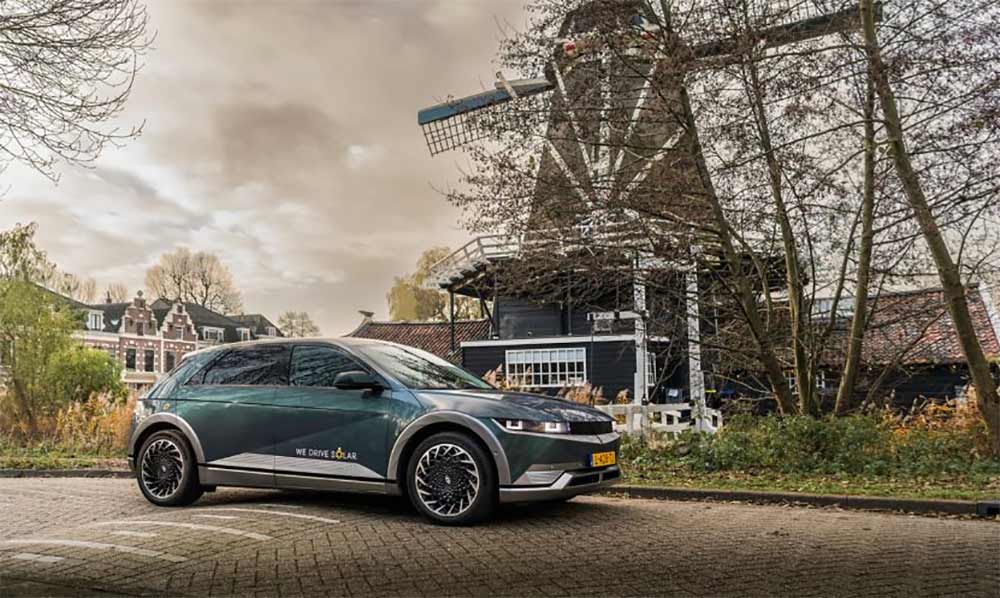With V2X, BEVs can feed electricity back into the public power grid
At IAA Mobility 2021, Hyundai announced that it will become climate-neutral by 2045. From 2035, the South Korean brand will only offer zero-emissions vehicles (ZEV, zero-emissions vehicle) in Europe. The cornerstone of this company’s strategy is to develop clean mobility solutions and technologies. This also includes “combined to everything” technology, or “V2X” for short. It summarizes a number of technological innovations that could stabilize the power grid and support the use of renewable energy sources – using power from pure battery electric vehicles (BEV, Battery Electric Vehicle).
Stabilizing the electricity grid and supporting renewable energies
An applied example of V2X is Vehicle to Network (V2G). This technology enables electricity from BEVs to be fed into the public power grid (English: grid). The energy landscape benefits from the use of BEVs as electricity suppliers, because e-model owners can actively contribute to the stability of their local electricity grid.
Hyundai V2X tests with modified Ioniq 5 in Germany
To reduce the impact of climate change, many countries are incorporating more and more renewable energy sources into their energy mix, including Germany. V2G technology can further support this process by reducing carbon dioxide emissions and reducing dependence on fossil fuels. Instead of running high-emission standby power plants, the power grid can use green electricity stored in the high-voltage batteries of e-vehicles, for example at night, when there is no wind or to absorb peak loads, since. It comes from solar or wind energy.
V2G for better control of energy demand
For example, if an electric car is not urgently used for driving purposes after work, but is parked in a public or private parking lot for several hours, the energy stored in its battery or parts of it can be returned to the grid via a special charging station. This electricity is then supplied to local power supply companies and, in the next step, to other users. Combined with a flexible electricity tariff, owners can charge their electric vehicles on time and at lower costs during peak periods, so that the e-car has enough battery capacity again once it is needed. With this system, network operators also benefit from significantly lower operating costs, for example due to the elimination of intermediate storage.
In order to be able to support V2G, BEVs must be equipped with the appropriate hardware. This includes a bi-directional charger that allows charging and discharging the vehicle’s traction battery. Adequate control over these functions also requires specially modified software.
Use electricity from BEV for your home
Electric cars can also power homes and buildings. In a closed electrical ecosystem independent of the public grid, BEV supplies electricity to the home, thus not only reducing home energy costs, but also reducing local grid demand. This use of BEV is summarized under the term Vehicle-to-Home (V2H) or referred to as Vehicle-to-Building (V2B) if the energy stored in electronic vehicles is used to supply a building, eg an office complex.
The modified Hyundai Ioniq 5 is being tested in two V2X beta projects
Hyundai is currently conducting two promising V2X pilot projects with the modified Hyundai Ioniq 5 in Germany and the Netherlands: one focusing on V2H and V2G.
The V2H pilot project is being implemented in Germany by Hyundai CRADLE (Center for Augmented Robotic Design in Live Experiments) in Berlin. The ability to share electricity with the home is being tested in a closed power system. Many modified Hyundai Ioniq 5s are equipped with the same on-board bi-directional charger that was already used in production E-CUV models. However, the experimental vehicles have a specific program to test V2H technology under everyday conditions.
Hyundai is also helping Utrecht become the world’s first two-way city in collaboration with Dutch mobility provider We Drive Solar. As part of the project, We Drive Solar will initially provide a fleet of 25 Hyundai Ioniq 5 vehicles for a car-sharing solution offered to residents of recent housing developments. In the next step, the V2G technology Hyundai uses in the modified Ioniq 5 will be tested using public charging stations developed by We Drive Solar for this purpose.


Hyundai relies on V2G technology in its cars
Hyundai’s Ioniq 5’s Electric Global Modular Platform (E-GMP) already allows charging and powering external electrical appliances. This can be used to power e-bikes, e-scooters or laptops with up to 230V AC while driving or when stationary. This technology is called Vehicle to Load (V2L) and produces up to 3.6 kW. This is enough, for example, to operate a medium-sized air conditioner or a 55-inch TV for up to 24 hours.
V2L and V2G are technically related, but they work with different software solutions. To exchange power with the power network in the context of V2G, a communication protocol must first be defined between the BEV and the network. Hyundai plans to use the onboard charger, which is suitable for bi-directional charging and is also installed in the Ioniq 5 model series for V2G technology at a later date. In addition, Hyundai will soon introduce a new electric vehicle that comes with pre-worked V2G technology.


“Certified tv guru. Reader. Professional writer. Avid introvert. Extreme pop culture buff.”







More Stories
Samsung Quantum Dot TV: Art meets technology
Pitch: €56m for energy startup Reverion
Plastoplan: Plastics for Energy Transition